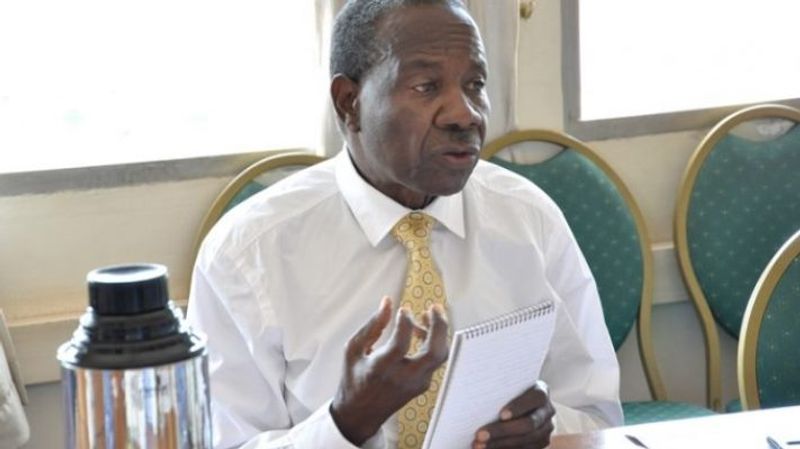
 If I were the Secretary to the Treasury or the Minister of Finance, I would do this either resign or shut up
If I were the Secretary to the Treasury or the Minister of Finance, I would do this either resign or shut up
It is Abba Eban (1915 – 2002), an Israeli diplomat and politician, who said,“Men and nations behave wisely once they have exhausted all other alternatives.”
Last week, one of the dailies came out with a screaming headline, “Muhakanizi warns government on rising debt.”Keith Muhakanizi is the Permanent Secretary and Secretary to the Treasury (PS/ST) at the Ministry of Finance, Planning and Economic Development (MoFPED).
Before getting the top job at Finance, Muhakanizi, between 1999 and 2004, served as Director for Economic Affairs; a position whose occupant advises the PS/ST on all issues concerning macroeconomic policy and debt.
Actually Keithled a team that convinced IMF to write off a $3.7 billion multilateral debt (about 85% of the country’s debt at the time) in 2005 when he was still the deputy secretary to the treasury.
For years now, papers have severally quoted him saying, “Borrowing for infrastructural projects is not sustainable. There is need for the Government to explore alternative means of raising funds to finance infrastructure investments [instead of borrowing].”
Being the chief adviser of government on fiscal policy, particularly on issuance and management of all government debt, I have always found it awkwardhearing Muhakanizi joining us (outsiders and powerless) to lamentabout the rising debt.
Who formulates Uganda’s fiscal policy?
I felt the best he could do (if he couldn’t get the ear of those he is supposed to officially advise) was either to resign or keep quiet. I may not be sure of everything, but what I am pretty sure Uganda cannot borrow any moneywhen Keith Muhakanizi, by virtue of his position, is not involved.
Last week I tweeted, “The Secretary to Uganda’s Treasury is warning himself in newspapers. Who exactly formulates Uganda’s fiscal policy? Who advises on it? Who sanctions it? Who implements it?”
Of course I knew who the chief Minister of Finance is. And he has never minced his words. President Yoweri Museveni has consistently said there was no need for Ugandans to worry over debt as long as it does not exceed the “50% danger zone”.
So we know who formulates the fiscal policy. We also thought we knew who advises on it and who implements it. Not until hecried out loud.
Truth of the matter is, Keith was right. Any economist or finance expert who has ever sat in a graduate school class knows debt-to-GDP ratios are irrelevant when assessing a nation’s debt position or likelihood to default.
Economists are taught to check not a number, but a qualitative point in debt. First they must ask: is the country’s debt issued in money it can freely print? In other words, is the country’s currency sovereign or not? If yes, a default can only happen as a political decision, as you can never run out of a commodity (domestic money) of which you are the monopoly supplier.
Uganda’s financial assets stand at 0.9%
In 2009 Greece (at 120% debt/GDP) defaulted and Japan (at 224%) did not and might never default. Why? Greece cannot print euros.Therefore, they were revenue constrained since the Greek government had to earn the euros needed to service its debt.Similarly, Uganda’s debt is issued to dollars. Thus we must also earn the dollarsneeded to service our debt.Japan, on the other hand,does not have to since it can print the yen in which its debt is issued.
Secondly, I learnt in my graduate school (and I am still learning) that what matters to assess default risk is a country’s ability to service its debt, and debt-to-GDP does not give much information on a country’s repayment ability.
Most importantly, GDP is not the resource of the government – it is a country’s resource as a whole, and neither is the gross debt the cash that the government has to pay.
Thirdly, if a number must be used, net debt (i.e. gross debt minus financial assets) to GDP should be used. Unlike debt-to-GDP ratio, the former helps to estimate the real debt situation of a country. Currently, our gross debt as percentage of GDPis44.8% and is projected to rise to 46.6% next year (IMF figures).
On the other hand Uganda’s financial assets (including domestic and foreign financial claims, special drawing rights, and goldnet of liabilities) as a percentage of GDP area paltry0.9% (World Bank figures). You can do the math, in relation to the gross debt above, and see how our situation is getting bad.
Are leaders looking into the future?
Fourthly, we were taught always to try as much as possible to establish the payment ability of a country i.e. the cost of the debt to be serviced.This is determined by the net interest service (NIS) as a percentage of GDP. Dividing it with the country’s tax burden gives an idea of the strain put on interest payments on government treasury.
For example, in Uganda before paying a single government employee, even before repaying debt principals paid 15% of public revenue as NIS. Anyone levelheaded should be worried even if our debt-to-GDP ratio is still in green (below 50%).
Fifth, it is advisable to always consider the debt burden ratio i.e. the ratio of debt to revenue. At personal level, if you pay UGX 20,000 in debt interest and have an income of UGX 400,000 your debt burden ratio is 5%. Now here is the killer; Japan (with a debt-to-GDP ratio of 238%,and projected to rise to 249% in 2020) has a debt burden ratio of only 4.3%.
On the other hand Uganda with a debt-to-GDP ratio of 41% has a debt burden ratio upwards 18%. Japan actually has one of the smallest debt burdens in the world. Why? Japan has quite a lot of leeway to increase taxes, while Uganda has less potential.
Finally, economists aretaught never to forget to look into the future. The simplest way to do this is to check the government’s structural budget balance by asking the question: is the country’s structural budget deficit below or above long-term inflation?
If it is below the country is safe otherwise it is in trouble no matter the debt-to-GDP ratio. It doesn’t require a genius(let alone calculations) to know that Uganda’s government’s structural budget balance is abovelong-term inflation.
So do our leaders think about the wellbeing of their children and grandchildren? Or again they use commonsense to think since they’re investing in roads and dams they have invested in the children’s future? Well, nice roads and dams did not stop Greece to go bankrupt. My point? Let’s mind about the debt we are accumulating beyond the debt-GDP-ratio.
Investing in egg shell and forgetting the yolk!
Yet even if we went by the traditional and politicians’ favourite metric of debt-to-GDP ratio, we are nearing crisis. Mira Clara, the International Monetary Fund (IMF) resident representative in Uganda was one time quoted by the media saying the ambitious infrastructure investment we embarked on would result into an increase in debt to about 50% of GDP in 2021.
We all appreciate the need to build infrastructure.What we are concerned about are two or three things: one, the failureto phase and sequence these infrastructureprojects. Second, the fact that the projects are being inefficiently implemented (expensive than usual, poorly fixed, and delayed) yet most of them are being funded using borrowed money. How shall we pay back?
Thirdly, we abandoned the essence of the “egg analogy” which the planners proposed at the start of the Vision 2040 to guide Uganda’s development agenda. We are investing more money in the egg shell (government, security, legislature, accountability etc.) than in itsyolk (agriculture, manufacturing, tourism, minerals and ICT).And we expect the egg to hatch.
When we raise these concerns, all we getare excuses how investment in infrastructure and security is synonymous with investment in tourism, industry and agriculture since they all need roads, electricity and security.
Some of us knowthe difference between investing in and investing for a sector,and how each performs in terms of return on investment. Empirical research, for example, shows that whereasinvesting a dollar in agriculturereturns 3.2 dollars, investing for agriculture (say in roads that transportthe agricultural produce) returnsonly 1.7 dollars.
I know some of these things I have written here donot make a lot of sense to someone who uses commonsense to appraise public investments more than economics. However, the day we shall struggle to find money to pay salaries orbuy utilities for government workers and offices, reality will hit us hard.And that day is not too far into the future, if it has not yet arrived.
That is why if I were the Secretary to the Treasury or the Minister of Finance, I would prepare my numbers in a simple and clear formatfor non-economists to understand,and present them to the Cabinet chaired by no one else but the President.
If I fail to convince the top-most decision-making organ of the state to see the reality as displayed the numbers and their qualitative implications, I either resign or forever shut up.














Ramathan Ggoobi
Ramathan Ggoobi is Policy Analyst, and Researcher. He lecturers economics at Makerere University Business School (MUBS) and has co-authored several studies on Uganda's economy. For the past ten years, he has published a weekly column 'Are You Listening Mr. President' in The Sunrise Newspaper, Uganda's Leading Weekly
Leave a Comment
Your email address will not be published.